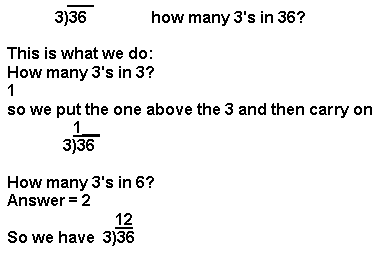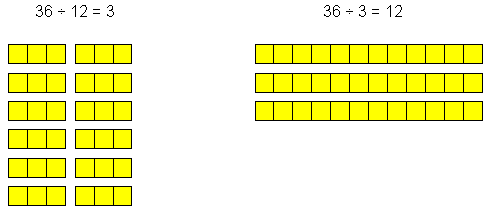
An Introduction to Multiplication
Welcome to first one of the questions that have been asked for by YOU. Each day for the next ten days we will cover a subject you have asked for. So don't be shy, ask away.
See the top of our SAT's question page for how to request a topic.
Division seems to be one of the hardest concepts to grasp in maths. Yet when it is understood,
it is then seen as being very easy.
Before we look at division and how to make it easier we are going to look at the
opposite (inverse) of division, multiplication.
The reason for this is because if you really understand multiplication then division is easier to understand.
Multiplication.
Multiplication is just a very quick way of adding numbers together.
2+2+2+2+2+2 = 12
How Many twos have you got here?
The answer is 6
So a quicker way of saying 2+2+2+2+2+2 is 2 X 6
If we need 6 2's to make 12, how many 6's do we need to make 12?
Answer = 2
6 + 6 = 12
Go to the table to find a quick way of writing the following: The first one has been done for you.
Table 1
| Question | How many of the number? | Multiplication | Answer |
| 3+ 3+ 3+3+3+3 | 6 | 3 X 6 | 18 |
| 7+7+7+7+7+7+7+7 | |||
| 4+4+4+4+4+4+4+4 | |||
| 5+5+5+5+5+5 | |||
| 2+2+2+2+2 | |||
| 9+9+9+9+9+9+9 |
| Question | How many of the number? | Multiplication | Answer |
| 3+ 3+ 3+3+3+3 | 6 | 3 X 6 | 18 |
| 7+7+7+7+7+7+7+7 | 8 | 7 X 8 | 49 |
| 4+4+4+4+4+4+4+4 | 8 | 4 X 8 | 32 |
| 5+5+5+5+5+5 | 6 | 5 X 6 | 30 |
| 2+2+2+2+2 | 5 | 2 X 5 | 10 |
| 9+9+9+9+9+9+9 | 9 | 7 X 9 | 63 |
That was easy wasn't it?
If there are 6 twos in 12. How many sixes = 12?
Answer = 2
6+ 6 = 12
This is very useful
I will show you this again with a different example:
How many 3's are needed to make 24?
3+3+3+3+3+3+3+3 = 24
Answer = 8
So 8 X 3 = 24
Can you guess how many 8's make 24 (without counting)?
The answer is 3
Hence 3 X 8 = 24 and 8 X 3 = 24
Now you see that we can reverse this multiplication and get the same
answer!
As soon as you hear that 2 X 9 = 18 (9 + 9)
You know that 9 X 2 = 18 (2+2+2+2+2+2+2+2+2)
This is what you are doing when you practise your times tables.
Here are some numbers multiply them together to find the product. The first one has been done for
you:
| Number | How many you have got | Multiplication | Reverse | Product |
| 5 | 4 | 5 X 4 | 4 X 5 | 20 |
| 7 | 6 | |||
| 4 | 6 | |||
| 5 | 3 | |||
| 9 | 5 | |||
| 6 | 5 | |||
| 3 | 9 |
Well how did you do?
| Number | How many you have got | Multiplication | Reverse | Product |
| 5 | 4 | 5 X 4 | 4 X 5 | 20 |
| 7 | 6 | 7 X 6 | 6 X 7 | 42 |
| 4 | 6 | 4 X 6 | 6 X 4 | 24 |
| 5 | 3 | 5 X 3 | 3 X 5 | 15 |
| 9 | 5 | 9 X 5 | 5 X 9 | 45 |
| 6 | 5 | 6 X 5 | 5 X 6 | 30 |
| 3 | 9 | 3 X 9 | 9 X 3 | 27 |
You see, multiplication is not that hard.
To make it easier you really need to know your tables and be able to recall some facts easily.
Now you might be able to see how division works.
For a taster we will show you a simple division.
Don't worry at this stage if this seems to hard, you will get the hang of it.
If we have the number 36 and we want to know how many 3's we have in 36. We write this

Here we are saying that 36 divided by 3 = 12.
What would you expect 36 divided by 12 to be?
The answer is 3
3 X 12 = 36 and 12 X 3 = 36
We can break 36 into groups of 12 ( we would have 3 groups), or we could break up 36 into groups of 3 and have twelve of them.
Lets look at this in picture form:

Review
Multiplication is a very quick way of adding up.
It does not matter which way we multiply, we get the same answer.
3 X 2 = 2+2+2 = 6
2 X 3 = 3+3 = 6
We call the result of a multiplication a product.
So the product of 2 X 3 is 6
What is the product of 6 and 4?
Answer 24 because 4 X 6 =24 and the product of 6 X 4 = 24
We can use this information to break numbers up into groups (division)
24 divided by 6 = 4
24 divided by 4 = 6
Next time we will look at division in greater detail.
Good Luck!